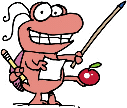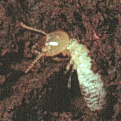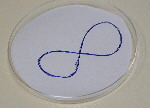
University of Kentucky Department of Entomology








Insects in the Classroom Lesson Plan No. 103
Termite Trails
Prepared by Caroline Stetter Neel, Extension SpecialistActivity DescriptionHands-on Discovery Lab Objectives
Academic ExpectationsThe above objectives fall under KERA's Science Academic Expectations or at least part in part.
TermitesBackground Information
Their food consists primarily of wood or other vegetable material. The workers are sterile and lack compound eyes. They do the main work of the colony-collecting food, feeding the queen, soldiers, and young as well as constructing galleries. Many species cause considerable damage to buildings, furniture, utility poses, fence posts, and other materials. In addition, termites are important decomposers breaking down dead trees and other plant materials into nutrients useful to plants. The cellulose in the termite's food is digested by protists living in the termite's digestive tract. This association is an excellent example of symbiosis or mutualism. Termites frequently groom each other with their mouthparts, a result of the attraction of secretions that are usually available on the body. Scientific Inquiry This lab is useful in introducing the scientific method or reinforcing it. It could be set up to be very structured or used as a discovery lab with few instructions.
What happens, is the termites will follow whatever design is drawn as long as the lines are heavy and well spaced. Figure eight works well but testing different designs may be part of the investigation. It turns out that the ink in the Papermate ballpoint has a substance that resembles pheromones that the termites recognize. Discovery Lab
More Structure? (Student Handout) Name _______________________ Materials: Petri dish, Paper, Papermate ballpoint pen, rollerball pen, Termites, forceps (tweezers), other pens and pencils, colored pencils, and scissors. Procedure: 2. Draw a large figure eight on the paper with the Papermate ballpoint provided (go over it several times with the pen) and place the paper in the petri dish. 3. Using forceps, CAREFULLY place a termite on the paper and observe its behavior. 4. Make a chart or table to record your data. Use the following: (termite responds) +, (no response) 0, (termite avoids the markings) - 5. Repeat steps 1-4 using the rollerball pen provided. 6. Now, suggest a hypothesis to be tested in an experiment. Use the other side of this paper to write down your hypothesis. 7. Test as many other pens and pencils as available and record your data in the table that you have made. 8. Test different designs drawn. 9. Make conclusions about you observations and give a scientific explanation as to why the termites respond as they do. (Student Handout ) Scientific Method Format
Observations: Hypothesis: Variables to be tested:
Control group:
Chart your data by making a table with these headings: (response) +, (no response) 0 , (avoidance) - Include the type of writing instument as a heading. Conclusion: Did your results support or refute your hypothesis?
Termites can be found in decaying logs and stumps in wooded areas. When it gets too dry, the termites burrow deep into the soil looking for moisture so may be difficult to locate. They may also be ordered from Carolina Biological Company or possibly a local exterminator may be able to provide a supply. They may last a few weeks if they have wood and are kept moist. The may be kept indefinately with very low maintenance making observations on new broods. References and ResourcesThis lab on Termite Tracking was adapted from one created by Lana Hayes of Simon Kenton High School in Independence, Kentucky.Carolina Biological Supply Company Wards Natural Science Establishment, Inc.
P.O. Box 92912 For More information and other resources, contact:
"Teacher Bug" and "Termite tracker" cartoons courtesy of C. Ware, copyright 1999 Original document: August 1999
|


 Return to UK Department of Entomology Katerpillars page
Return to UK Department of Entomology Katerpillars page Return to UK Department of Entomology homepage
Return to UK Department of Entomology homepage Return to University of Kentucky homepage
Return to University of Kentucky homepage